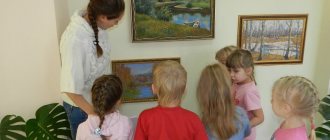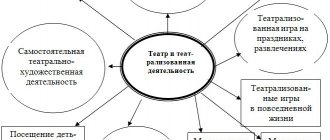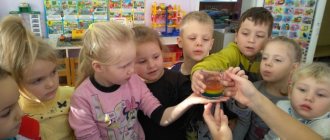“Methods and techniques for introducing preschool children to art.”
Author: Vasilyeva Alena Alexandrovna
Artistic and aesthetic development involves the development of prerequisites for value-semantic perception and understanding of works of art (verbal, musical, visual), the natural world, the formation of an aesthetic attitude to the surrounding world, the formation of elementary ideas about the types of arts; perception of music, fiction, folklore; stimulating empathy for characters in works of art; implementation of independent creative activities of children (visual, constructive-model, musical, etc.)
For the successful implementation of the educational field “Artistic Creativity” in early preschool age, the following methods and techniques are used.
1 Experimenting with visual material
(“What can you turn a handprint into?”, “What color is the sky?”, “What are the lines?”), using combinations of techniques and materials already mastered by children (complete a gouache drawing with colored felt-tip pens, add appliqué elements to the drawing, “draw” plasticine). Using various non-traditional techniques in drawing (palmprint, fingerprint, objects, potato stamps).
2 Gaming techniques
, which make it possible to interest preschoolers in the upcoming activity, facilitate the determination of the plan for future work, intensify the playing out of results and the transition of productive activity into play.
3 Examination, discussion, playing
a variety of aesthetically attractive items (folk craft items, interesting photographs, blanks, such as plaster toys for painting, disposable plates for painting, painting elements (albums, sheets), as well as “designing” the environment with their help.
4 Board and printed games
to develop the ability to distinguish and compare patterns, elements, shapes (games “Haze Patterns”, “Folk Art”).
5 Creating an exercise situation
, for which in the creativity corner you should provide options for coloring books, blanks (sheets with a printed pattern or parts thereof), children's magazines with creative tasks; placement in a visible place of “semi-finished materials” (sheets of different shapes and colors for drawing and appliques, blanks with printed figures, “unfinished compositions” - artistic material for individual and collective work.
6 Activities and games to enhance sensory experiences
, development of investigative actions, analytical skills, mastery of sensory standards, which are important in this age group. In the corners of creativity it is necessary to place “sensory sets” (collections of scraps or cardboard of different colors and shades, shapes, textures), models depicting various shapes, figures, lines, the “Rainbow” model (or its variant), sets of imaginative and interesting toys of different size, material for examination, examination and play.
7 Using Arts Synthesis and Activities Integration
- composing a story based on a picture, inventing a story, riddles, acting out the plot, selecting musical accompaniment, sounds for the image (“scoring the picture”)
The content of the area is integrated with the following educational areas: “Socio-communicative development”, “Cognitive development”, “Speech development”.
In older preschool age, it is advisable to use the following methods and techniques.
Review, discussion, aesthetic assessment
a variety of attractive objects: variety and expressiveness of shapes, shades, patterns, textures.
Talk
about art, aesthetic objects, visual techniques and tools.
Reading
educational literature, examination of colorful encyclopedias.
Consideration
aesthetic objects, creating exhibitions, crafts to decorate the group, items for games, involving children in design activities.
Research.
Children's play projects (“Rainbow in a box of paints”, “Mysterious artist’s tools” “What are still lifes?”; conversations “What else would you like to see?” “Do you know how to get such shades?” “How do objects get into the museum?”
Excursions
to art and local history museums, galleries, exhibitions. Preschoolers visit museums with their parents. Children and parents play projects “Our Favorite Museum”, “How We Traveled...”, “Museum at Our Home: Our Family Collection” are organized.
Situations of individual and collective creativity,
promoting the development of the ability to relate one’s interests to the desires of other children, the desire to come to an agreement with each other, and to enjoy the common result.
Use of modern information technologies:
resources for virtual excursions and museums, visual videos, electronic catalogs and games, creative sites for children.
Exercises and games
developing aesthetic, sensory and creative abilities (games “Find a Pair”, “Choose a Palette”, “Transform Shapes”, exercises “Complete the Figures”, “Blots”), situations for the development of association, aesthetic synesthesia.
Using Arts Synthesis and Activities Integration
in the process of educational situations involving comparison of images created by different types of art - music, literature, fine arts (images of the Snow Maiden, Spring, Winter, Baba Yaga, Dwarfs, birds and animals) Creation of creative works using different types of activities, visual techniques and materials : fantasy on the themes “Sounds of colors”, “Autumn melodies”, “Dances of shapes”, “Colors of joy and sadness”;
a combination of drawing and appliqué, drawing and sculpting, the use of non-traditional visual techniques (collage, paper plastic, plasticineography, isothread. The content of the section is integrated
with the following educational areas: “Social and communicative development”, “Cognitive development”, “Speech development”.
Thus, the choice of method and techniques for introducing preschool children to art depends on:
- on the content and objectives of the lesson to familiarize preschool children with art;
- on the age of the children and their level of development.
comments powered by HyperComments
M. Caravaggio “Fruit Basket”
M. Caravaggio “Fruit Basket” (1597)
The Italian artist Michelangelo de Caravaggio (1571-1610) is considered a reformer of European painting in the 17th century, the founder of realism and one of the greatest masters of Baroque painting.
“Fruit Basket” was painted by a 22-year-old artist more than 400 years ago and is considered the first still life painting in the history of painting. The young master forever went down in history as the founder of this genre, innovative for that time.
What kind of genre is still life?
This is an image of objects and things that relate to everyday life and everyday life of people. Still lifes, as a rule, do not contain any plot, except for the composition itself, assembled from two or more objects. The artist's task is to capture objects as they are. In this case, Caravaggio tried to depict the fruit as naturally as possible. Some of them look like they were just picked and carelessly thrown into a basket. In some places the image even resembles a photograph. Task for the child:
Ask your child: what does he see in the picture? What fruits are shown on it? What color are they?
I. Aivazovsky “Rainbow”
I. Aivazovsky “Rainbow” (1873)
The painting “Rainbow” is one of 4,000 works that the outstanding 19th century marine painter Ivan Aivazovsky (1817-1900) dedicated to the water element. On his canvases he depicted more than a dozen seas on different continents. In total, during his life the artist created about 6,000 thousand paintings.
Aivazovsky was born in Crimea and fell in love with the sea from early childhood. He could sit on the shore for hours, peer into every detail and admire the beauty of the seascape. In the future, this allowed him to very realistically depict the various states of sea water.
All the artist’s work is colored with the features of romanticism.
Therefore, the water element in Aivazovsky’s canvases is most often stormy and restless, just like in the painting “Rainbow”. This is the story of one crash with a happy ending. The small ship, unable to withstand the blows of the elements, tilted treacherously and was about to sink. People, in the hope of salvation, moved into tiny boats and continue to withstand the menacing storm. In a doomed situation, the painter gives hope for the best: he depicts a small seagull, which seems to show people the path to salvation. And the rainbow is a favorite motif of romantics and a biblical symbol of the end of the flood. Task for the child:
Let the child look carefully at the picture and find the seagull and the rainbow. What's happening at sea? What colors is the work done in?
V. Polenov “Moscow courtyard”
V. Polenov “Moscow courtyard” (1873)
This is one of the most famous paintings by the Russian landscape painter and master of genre painting Vasily Polenov (1844-1927). With this work the artist made his debut at the 6th exhibition of the Association of Itinerants.
It is interesting that Polenov painted the picture in a hurry and was not entirely happy with it. However, "Moscow Yard" was a huge critical success. The work, in their opinion, stood out from the background of other works with some special poetry and elegiac Turgenev mood.
After “Moscow Courtyard,” Polenov was dubbed the master of “intimate” landscape, which means “deeply personal, sincere, intimate.” In general, the very concept of “intimate landscape” suits any painting in which one can feel the emotional state of its author.
The picture became iconic for the history of Moscow.
Thanks to it, you can look into the past and imagine what the city was like in the 1870s. In the 19th and 20th centuries, the main urban planning unit of the city was not streets and squares, but the house and courtyard. At that time, mansions sometimes occupied entire blocks and were surrounded by gardens and courtyard buildings. By the way, the Church of the Savior in Peski near Arbat, depicted in the picture, has been preserved in almost the same form in the capital to this day. Task for the child:
Ask your child: what does he see in the picture? What are the children and the woman doing? What time of year is shown? What animals and birds does he see?
V. Vasnetsov “The Sleeping Princess”
V. Vasnetsov “The Sleeping Princess” (1900-1926)
The famous Russian artist Viktor Vasnetsov (1848-1926) painted this painting, “The Sleeping Princess,” which is familiar to us from childhood, for almost 40 years, but never finished it. The general public saw the work after the author’s death, at an exhibition in 1927. The film was a huge success and was recognized as one of Vasnetsov’s best works.
“The Sleeping Princess” is part of the “Poem of Seven Tales” cycle, and the plot is based on “The Tale of the Dead Princess and the Seven Knights” by Alexander Pushkin and “The Sleeping Beauty” by Charles Perrault. The artist chose the episode when the young princess pricked herself with a spindle and fell into a long hundred-year sleep, and her entire kingdom fell asleep with her.
Vasnetsov is considered one of the first master painters who brought to life on his canvases the magical world of Russian fairy tales and epics. The artist's interest in ancient Russian culture arose while studying at a theological school and then at a seminary, where he studied the lives of saints, chronographs, chronicles, parables and folklore. Vasnetsov wrote about himself: “I am a storyteller, a writer of epics, a guslar of painting.”
In all the artist’s paintings, contemporaries noted the highest decorative skill of the artist, the variety of colors, ornaments and patterns in the traditions of Russian architecture.
It should be noted that during his life, Viktor Vasnetsov made contributions to a wide variety of areas of art - theatrical scenery and costumes, architecture and applied arts.
He created illustrations for the works of Pushkin and Lermontov, and devoted over ten years of his creative life to working on the paintings of the Vladimir Cathedral in Kyiv. He also created sketches of the main facade of the Tretyakov Gallery in Lavrushinsky Lane in Moscow. Task for the child:
Ask your child: who and what does he see in the picture? Let him remember the fairy tale? What colors did the artist use to paint the picture?





